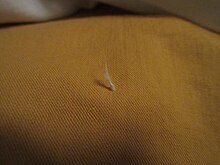Down tightness
The down-tightness (actually feather-tightness ) describes a material property that is supposed to prevent feathers from leaking through the fabric . These fabrics are also known as downproof or featherproof fabrics.
General
Down-proof fabrics are down-impermeable textiles, especially for bed linen and clothing. The so-called down-tightness can be achieved in different ways: If the quality is good, the ticking fabrics are woven very tightly and a filling finish is dispensed with, or the fabric pores are glued with a filling finish. Alternatively, a good surface seal can be achieved with the help of a corrugated calender .
Many manufacturers do not give a 100% guarantee that their fabric is down-proof, as feathers keep coming out. Materials such as cotton and nylon in a close-meshed plain weave are used. For satin sheets also is satin weave used with the state bond also can be generated feather woven fabric.
However, the right balance must always be found with the downproof fabric, as solid fabrics that would not let anything through would be possible, but the laundry would then no longer be soft and comfortable. In addition, this material would lose features such as breathability and heat exchange . In English, this function is referred to as down-proof fabric or feather-proof fabric .
Actually, it's not the down that pierces the fabric, as it doesn't have a solid keel. Down duvets may have a proportion of the cheaper, but quill-equipped feathers. Cushions, for example, should have a high proportion of feathers to give them sufficient strength. For blankets that are only filled with down, a very thin, open-pored woven fabric can be used.
Tests to determine the down impermeability of fabrics are regulated by the DIN EN 12132-1: 1998-10 standard of the German Institute for Standardization .
history
Until the 1960s, people had a lot of loose down in their beds because the ticking was not down-tight. With the invention of the so-called downproof, actually featherproof fabrics, this decreased significantly.
Downproof equipment
The downproof finish is a washable finish for fine cotton fabrics, in which the spaces between the fabrics are completely filled with polyacrylic resin or polyvinyl resin . The resins go in the subsequent heat treatment into a hard detachable state, it follows a final calendering . For filling with boil-proof down, the inlet is also made boil-proof.
Individual evidence
- ^ A b Alfons Hofer: Textile and Model Lexicon. 7th edition. Volume 1, Deutscher Fachverlag, Frankfurt am Main 1997, ISBN 3-87150-518-8 , keywords “down-proofing equipment”, “Inlett”.
- ↑ Thomas Meyer zu Capellen: Lexicon of fabrics: technology - bindings - trade names . dfv Mediengruppe Fachbuch, January 5, 2016. Last accessed July 17, 2019.
- ↑ beuth.de: DIN EN 12132-1: 1998-10 Down and feathers - Method for testing the down-tightness of fabrics - Part 1: Simulated cushion stress; German version EN 12132-1: 1998 . Date of issue October 1998. Last accessed July 16, 2019.

